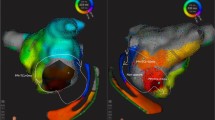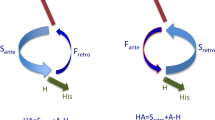Abstract
Background
Recent anatomic and electrophysiologic evidence has provided new insight into the anatomic substrate. Previous reports on electroanatomic mapping (EAM) of the circuit of atrioventricular nodal reentrant tachycardia (AVNRT) have been limited by mapping only the triangle of Koch on the right side of the septum and by the use of conventional mapping tools. The objectives are to obtain comprehensive high-resolution mapping of typical AVNRT and to investigate the role of the atrioventricular ring tissues in the circuit.
Methods
We employed EAM with the use of novel modules and algorithms for studying typical AVNRT from the right and the left sides of the septum.
Results
We performed extensive mapping of both the atrial septum and the septal vestibule of the tricuspid valve during typical AVNRT in 9 (6 females) patients, aged 49.6 ± 12.1 years. In two of these, left septal mapping was also obtained through the aorta. The earliest initial activation was variable, emanating from the superior or medial septum. The impulse consistently appeared below the orifice of the coronary sinus, at the site where its inferoanterior margin merged with the septal vestibule of the tricuspid valve at its entrance to the right atrium. It then returned to the initial activation site, presumably through the septal vestibular myocardium. The left septal activation area corresponded to that recorded on the right side.
Conclusions
Typical AVNRT uses a circuit confined within the pyramid of Koch from the AV node to the septal isthmus, involving the myocardial walls of the pyramidal space.







Modified from: Katritsis DG, Anderson RH. New insights into the mechanisms of fast and slow conduction in the atrioventricular node. Heart Rhythm. 2022. 10.1016/j.hrthm.2022.08.025
Similar content being viewed by others
References
Anderson RH, Sanchez-Quintana D, Mori S, Cabrera JA, Back SE. Re-evaluation of the structure of the atrioventricular node and its connections with the atrium. Europace. 2020;22:821–30. https://doi.org/10.1093/europace/euaa031.
Anderson RH, Sanchez-Quintana D, Mori S, Lokhandwala Y, Correa FS, Wellens HJ, Sternick EB. Unusual variants of pre-excitation: from anatomy to ablation: Part I-Understanding the anatomy of the variants of ventricular pre-excitation. J Cardiovasc Electrophysiol. 2019;30:2170–80. https://doi.org/10.1111/jce.14106.
Katritsis DG, Marine JE, Katritsis G, Latchamsetty R, Zografos T, Zimetbaum P, Buxton AE, Calkins H, Morady F, Sanchez-Quintana D, Anderson RH. Spatial characterization of the tachycardia circuit of atrioventricular nodal re-entrant tachycardia. Europace. 2021;23:1596–602. https://doi.org/10.1093/europace/euab130.
Katritsis DG, Zografos T, Siontis KC, Giannopoulos G, Muthalaly RG, Liu Q, Latchamsetty R, Varga Z, Deftereos S, Swerdlow C, et al. Endpoints for successful slow pathway catheter ablation in typical and atypical atrioventricular nodal re-entrant tachycardia: a contemporary, multicenter study. JACC Clin Electrophysiol. 2019;5:113–9. https://doi.org/10.1016/j.jacep.2018.09.012.
Katritsis DG, Calkins H, Anderson RH. The specialized atrioventricular ring tissues participate in the circuit of atrioventricular nodal reentrant tachycardia. J Am Heart Assoc. 2021;10:e022811. https://doi.org/10.1161/JAHA.121.022811.
Katritsis DG, Anderson RH. New insights into the mechanisms of fast and slow conduction in the atrioventricular node. Heart Rhythm. 2022. https://doi.org/10.1016/j.hrthm.2022.08.025.
Katritsis D, Tretter JT, Marine JE, Calkins H, Anderson RH. Quantitative assessment of the fast pathway in atrioventricular nodal reentrant tachycardia. J Interv Cardiac Electrophysiol. 2023;66:991–996.
Chua K, Upadhyay GA, Lee E, Aziz Z, Beaser AD, Ozcan C, Broman M, Nayak HM, Tung R. High-resolution mapping of the triangle of Koch: spatial heterogeneity of fast pathway atrionodal connections. Heart Rhythm. 2018;15:421–9. https://doi.org/10.1016/j.hrthm.2017.10.030.
Pandozi C, Lavalle C, Bongiorni MG, Catalano A, Pelargonio G, Russo M, Piro A, Carbone A, Narducci ML, Galeazzi M, et al. High-density mapping of Koch’s triangle during sinus rhythm and typical AV nodal reentrant tachycardia: new insight. J Interv Card Electrophysiol. 2020. https://doi.org/10.1007/s10840-020-00841-8.
Steinberg BA, Piccini JP. High-density mapping of the tachycardia circuit in atrioventricular nodal reentrant tachycardia. HeartRhythm Case Rep. 2016;2:451–3. https://doi.org/10.1016/j.hrcr.2016.02.006.
Kaseno K, Hasegawa K, Miyazaki S, Mukai M, Aoyama D, Nodera M, Hirano K, Otake M, Nomura R, Miyahara K, et al. Discrepancy between CARTO and Rhythmia maps for defining the left atrial low-voltage areas in atrial fibrillation ablation. Heart Vessels. 2021;36:1027–34. https://doi.org/10.1007/s00380-021-01773-7.
Yanni J, Boyett MR, Anderson RH, Dobrzynski H. The extent of the specialized atrioventricular ring tissues. Heart Rhythm. 2009;6:672–80. https://doi.org/10.1016/j.hrthm.2009.01.021.
Katritsis DG, Josephson ME. Differential diagnosis of regular, narrow-QRS tachycardias. Heart Rhythm. 2015;12:1667–76. https://doi.org/10.1016/j.hrthm.2015.03.046.
Tretter JT, Spicer DE, Sanchez-Quintana D, Back Sternick E, Farre J, Anderson RH. Miniseries 1-Part III: ‘Behind the scenes’ in the triangle of Koch. Europace. 2022;24:455–63. https://doi.org/10.1093/europace/euab285.
Anter E, Tschabrunn CM, Buxton AE, Josephson ME. High-resolution mapping of postinfarction reentrant ventricular tachycardia: electrophysiological characterization of the circuit. Circulation. 2016;134:314–27. https://doi.org/10.1161/CIRCULATIONAHA.116.021955.
Martin CA, Takigawa M, Martin R, Maury P, Meyer C, Wong T, Shi R, Gajendragadkar P, Frontera A, Cheniti G, et al. Use of novel electrogram “Lumipoint” algorithm to detect critical isthmus and abnormal potentials for ablation in ventricular tachycardia. JACC Clin Electrophysiol. 2019;5:470–9. https://doi.org/10.1016/j.jacep.2019.01.016.
Katritsis DG. A unified theory for the circuit of atrioventricular nodal re-entrant tachycardia. Europace. 2020;22:1763–7. https://doi.org/10.1093/europace/euaa196.
Katritsis DG, John RM, Latchamsetty R, Muthalaly RG, Zografos T, Katritsis GD, Stevenson WG, Efimov IR, Morady F. Left septal slow pathway ablation for atrioventricular nodal reentrant tachycardia. Circ Arrhythm Electrophysiol. 2018;11:e005907. https://doi.org/10.1161/CIRCEP.117.005907.
Bisceglia C, Frontera A, Della BP. The LUMIPOINT software: are we just at the turning point? Europace. 2019;21:iii25–6. https://doi.org/10.1093/europace/euz144.
Martin R, Hocini M, Haisaguerre M, Jais P, Sacher F. Ventricular tachycardia isthmus characteristics: insights from high-density mapping. Arrhythm Electrophysiol Rev. 2019;8:54–9. https://doi.org/10.15420/aer.2018.78.2.
Katritsis DG, Calkins H, Anderson RH. The Specialized Atrioventricular Ring Tissues Participate in the Circuit of Atrioventricular Nodal Reentrant Tachycardia. J Am Heart Assoc. 2021;16:10(22):e022811. https://doi.org/10.1161/JAHA.121.022811.
Bohora S, Lokhandwala Y, Sternick EB, Anderson RH, Wellens HJJ. Reappraisal and new observations on atrial tachycardia ablated from the non-coronary aortic sinus of Valsalva. Europace. 2018;20:124–33. https://doi.org/10.1093/europace/euw324.
Kaneko Y, Nakajima T, Irie T, Suzuki F, Ota M, Iijima T, Tamura M, Iizuka T, Tamura S, Saito A, Kurabayashi M. Successful ablation of atypical atrioventricular nodal reentrant tachycardia from a noncoronary sinus of Valsalva. Int Heart J. 2014;55:84–6. https://doi.org/10.1536/ihj.13-218.
Katritsis DG, Efimov IR. Cardiac connexin genotyping for identification of the circuit of atrioventricular nodal re-entrant tachycardia. Europace. 2019;21:190–1. https://doi.org/10.1093/europace/euy099.
Okumura Y, Watanabe I, Yamada T, Ohkubo K, Masaki R, Sugimura H, Hashimoto K, Kofune T, Takagi Y, Wakita R, et al. Comparison of coronary sinus morphology in patients with and without atrioventricular nodal reentrant tachycardia by intracardiac echocardiography. J Cardiovasc Electrophysiol. 2004;15:269–73. https://doi.org/10.1046/j.1540-8167.2004.03114.x.
Acknowledgements
We are grateful to Theodoros Xenos and Stylianos Tsakiroglou for their incredible technical help.
Author information
Authors and Affiliations
Corresponding author
Ethics declarations
Ethics approval and consent to participate
The study has received ethical approval in all participating centres. All patients have provided a written, informed consent.
Conflict of interest
The authors declare no competing interests.
Additional information
Publisher's Note
Springer Nature remains neutral with regard to jurisdictional claims in published maps and institutional affiliations.
Supplementary Information
Below is the link to the electronic supplementary material.
Supplementary file1 (MP4 2738 KB)
Rights and permissions
Springer Nature or its licensor (e.g. a society or other partner) holds exclusive rights to this article under a publishing agreement with the author(s) or other rightsholder(s); author self-archiving of the accepted manuscript version of this article is solely governed by the terms of such publishing agreement and applicable law.
About this article
Cite this article
Katritsis, D.G., Fragakis, N., Katritsis, G. et al. High-resolution mapping of the circuit of typical atrioventricular nodal reentrant tachycardia. J Interv Card Electrophysiol 67, 599–607 (2024). https://doi.org/10.1007/s10840-023-01632-7
Received:
Accepted:
Published:
Issue Date:
DOI: https://doi.org/10.1007/s10840-023-01632-7




